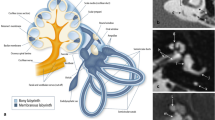Summary
The ultrastructure of human spermatozoa located in the cumulus cells and the zona pellucida of a pronuclear egg, and in the zona pellucida of a two-cell egg, both fertilized in-vivo, has been analysed in order to understand how the human spermatozoon penetrates the investing coats of the oocyte. Among the 36 spermatozoa found in the cumulus cells, 31 were phagocytosed by cumulus cells and 5 were wedged in the matrix between the cells. These spermatozoa were acrosome-reacted and their equatorial segment was intact. Six of the seven spermatozoa found in the zona pellucida (four spermatozoa in the pronuclear egg and three in the two-cell egg) had lost the equatorial segment, while the other one was partially reacted. The sperm heads were located in slits with sharp edges. From these findings it was concluded that in the human (1) only few and normal spermatozoa seem to reach the cumulus cells after natural insemination, (2) the acrosome reaction probably occurs sometime before the spermatozoa reach the vicinity of the corona cells, (3) the reaction of the equatorial segment seems to occur during or before the initial phase of zona penetration, since the spermatozoa located in the matrix of the zona pellucida had no equatorial segment. No evidence of the presence of spermatozoa with an intact acrosome in the matrix of cumulus cells or with an intact equatorial segment in the zona pellucida were found.
Similar content being viewed by others
References
Ahlgren M, Bostrom K, Malqrist R (1973) Sperm transport and survival in women with special reference to the Fallopian tube. INSERM 26:183–200
Asch RH (1976) Laparoscopic recovery of sperm from peritoneal fluid, in patients with negative or poor Sims-Huhner test. Fertil Steril 27:1111–1114
Bedford JM (1983) Oocyte structure and the design and function of the sperm head in Eutherian mammals. In: J André (ed) The sperm cell, Martinus Nijhoff Publ. The Hague, The Netherlands pp 75–89
Brown CR, Hartree EF (1975) An acrosin inhibitor in ram spermatozoa that does not originate from the seminal plasma. Hoppe-Seylers Z Physiol Chem 356:1909–1913
Cummins JM, Yanagimachi R (1982) Sperm-egg ratios and the site of the acrosome reaction during in vivo fertilization in the hamster. Gamete Res 5:239–256
Elstein M (1978) Morphology of cervical mucus and its clinical assessment. In: H Ludwing, PF Tanber (eds) Human Fertilization, G. Thieme, Stuttgart pp 68–79
France JT (1981) Overview of the biological aspects of the fertile period. Int J Fertil 26:143–152
Harrison RAP (1983) The acrosome, its hydrolases and egg penetration. In: J André (ed) The sperm cell, Martinus Nijhoff Publ. The Hague, The Netherlands: pp 259–273
Hartree EF (1977) Spermatozoa, eggs and proteinases. Biochem Soc Trans 5:375–394
Huang TTF, Fleming AD, Yanagimachi R (1981) Only acrosome-reacted spermatozoa can bind to and penetrate Zona Pellucida: A study using the guinea pig. J Exp Zool 217:287–290
Huneau D, Harrison RAP, Fléchon J-E (1983) Ultrastructural localization of proacrosin and acrosin during the acrosome reaction in ram spermatozoa. In: J André (ed) The sperm cell, Martinus Nijhoff Publ. The Hague, The Netherlands, pp 286–289
Kopecný V, Fléchon J-E (1981) Fate of acrosomal glycoproteins during the acrosomal reaction and fertilization: a light and electron microscope autoradiographic study. Biol Reprod 24:201–216
McMaster R, Yanagimachi R, Lopata A (1978) Penetration of human eggs by human spermatozoa in vitro. Biol Reprod 19:212–216
Pereda J, Coppo M (1984a) Ultrastructure of the cumulus cell mass surrounding a human egg in the pronulear stage. Anat Embryol 170:107–112
Pereda J, Coppo M (1984b) Ultrastructure of a two-cell human embryo fertilized in vivo. J IVF and ET 1:131
Pereda J, Croxatto HB (1977) Ultrastructure of human eggs. 2nd International Congress of Human Reproduction. Tel Aviv, Israel, October
Reynolds ES (1963) The use of citrate at high pH as an electronopaque stain in electron microscopy. J Cell Biol 17:208–212
Soupart P, Strong PA (1974) Ultrastructural observations on human oocytes fertilized in vitro. Fertil Steril 25:11–43
Talbot P (1984) Hyaluronidase dissolves a component of the hamster zona pellucida. J Exp Zool 229:309–316
Yanagimachi R (1981) Mechanisms of fertilization in mammals. In: L Mastroianni, JD Biggers (eds) Fertilization and embryonic development in vitro. Plenum, New York, pp 81–182
Author information
Authors and Affiliations
Rights and permissions
About this article
Cite this article
Pereda, J., Coppo, M. An electron microscopic study of sperm penetration into the human egg investments. Anat Embryol 173, 247–252 (1985). https://doi.org/10.1007/BF00316305
Accepted:
Issue Date:
DOI: https://doi.org/10.1007/BF00316305




